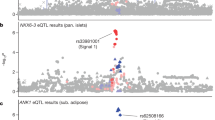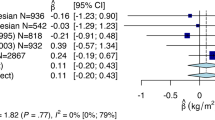Abstract
Multiple genetic loci associated with obesity or body mass index (BMI) have been identified through genome-wide association studies conducted predominantly in populations of European ancestry. We performed a meta-analysis of associations between BMI and approximately 2.4 million SNPs in 27,715 east Asians, which was followed by in silico and de novo replication studies in 37,691 and 17,642 additional east Asians, respectively. We identified ten BMI-associated loci at genome-wide significance (P < 5.0 × 10−8), including seven previously identified loci (FTO, SEC16B, MC4R, GIPR-QPCTL, ADCY3-DNAJC27, BDNF and MAP2K5) and three novel loci in or near the CDKAL1, PCSK1 and GP2 genes. Three additional loci nearly reached the genome-wide significance threshold, including two previously identified loci in the GNPDA2 and TFAP2B genes and a newly identified signal near PAX6, all of which were associated with BMI with P < 5.0 × 10−7. Findings from this study may shed light on new pathways involved in obesity and demonstrate the value of conducting genetic studies in non-European populations.
This is a preview of subscription content, access via your institution
Access options
Subscribe to this journal
Receive 12 print issues and online access
$209.00 per year
only $17.42 per issue
Buy this article
- Purchase on Springer Link
- Instant access to full article PDF
Prices may be subject to local taxes which are calculated during checkout



Similar content being viewed by others
References
Frayling, T.M. et al. A common variant in the FTO gene is associated with body mass index and predisposes to childhood and adult obesity. Science 316, 889–894 (2007).
Scuteri, A. et al. Genome-wide association scan shows genetic variants in the FTO gene are associated with obesity-related traits. PLoS Genet. 3, e115 (2007).
Loos, R.J. et al. Common variants near MC4R are associated with fat mass, weight and risk of obesity. Nat. Genet. 40, 768–775 (2008).
Thorleifsson, G. et al. Genome-wide association yields new sequence variants at seven loci that associate with measures of obesity. Nat. Genet. 41, 18–24 (2009).
Willer, C.J. et al. Six new loci associated with body mass index highlight a neuronal influence on body weight regulation. Nat. Genet. 41, 25–34 (2009).
Meyre, D. et al. Genome-wide association study for early-onset and morbid adult obesity identifies three new risk loci in European populations. Nat. Genet. 41, 157–159 (2009).
Scherag, A. et al. Two new loci for body-weight regulation identified in a joint analysis of genome-wide association studies for early-onset extreme obesity in French and German study groups. PLoS Genet. 6, e1000916 (2010).
Speliotes, E.K. et al. Association analyses of 249,796 individuals reveal 18 new loci associated with body mass index. Nat. Genet. 42, 937–948 (2010).
Chambers, J.C. et al. Common genetic variation near MC4R is associated with waist circumference and insulin resistance. Nat. Genet. 40, 716–718 (2008).
McCarthy, M.I. Genomics, type 2 diabetes, and obesity. N. Engl. J. Med. 363, 2339–2350 (2010).
Cho, Y.S. et al. A large-scale genome-wide association study of Asian populations uncovers genetic factors influencing eight quantitative traits. Nat. Genet. 41, 527–534 (2009).
Deurenberg, P., Deurenberg-Yap, M. & Guricci, S. Asians are different from Caucasians and from each other in their body mass index/body fat per cent relationship. Obes. Rev. 3, 141–146 (2002).
de Bakker, P.I. et al. Practical aspects of imputation-driven meta-analysis of genome-wide association studies. Hum. Mol. Genet. 17, R122–R128 (2008).
W.H.O. Expert Consultation. Appropriate body-mass index for Asian populations and its implications for policy and intervention strategies. Lancet 363, 157–163 (2004).
Voight, B.F. et al. Twelve type 2 diabetes susceptibility loci identified through large-scale association analysis. Nat. Genet. 42, 579–589 (2010).
Zeggini, E. et al. Replication of genome-wide association signals in UK samples reveals risk loci for type 2 diabetes. Science 316, 1336–1341 (2007).
Steinthorsdottir, V. et al. A variant in CDKAL1 influences insulin response and risk of type 2 diabetes. Nat. Genet. 39, 770–775 (2007).
Winkler, C. et al. BMI at age 8 years is influenced by the type 2 diabetes susceptibility genes HHEX-IDE and CDKAL1. Diabetes 59, 2063–2067 (2010).
Veyrieras, J.B. et al. High-resolution mapping of expression-QTLs yields insight into human gene regulation. PLoS Genet. 4, e1000214 (2008).
Okada, Y. et al. Common variants at CDKAL1 and KLF9 loci are associated with body mass index in east Asian populations. Nat. Genet. published online, doi:10.1038ng.1086 (12 February 2012).
Benzinou, M. et al. Common nonsynonymous variants in PCSK1 confer risk of obesity. Nat. Genet. 40, 943–945 (2008).
Wingender, E. et al. TRANSFAC: an integrated system for gene expression regulation. Nucleic Acids Res. 28, 316–319 (2000).
Gamazon, E.R. et al. SCAN: SNP and copy number annotation. Bioinformatics 26, 259–262 (2010).
Dandona, P. et al. Increased plasma concentration of macrophage migration inhibitory factor (MIF) and MIF mRNA in mononuclear cells in the obese and the suppressive action of metformin. J. Clin. Endocrinol. Metab. 89, 5043–5047 (2004).
Yang, T.P. et al. Genevar: a database and Java application for the analysis and visualization of SNP-gene associations in eQTL studies. Bioinformatics 26, 2474–2476 (2010).
Zeggini, E. & Ioannidis, J.P. Meta-analysis in genome-wide association studies. Pharmacogenomics 10, 191–201 (2009).
Cochran, W.G. The combination of estimates from different experiments. Biometrics 10, 101–129 (1954).
Devlin, B. & Roeder, K. Genomic control for association studies. Biometrics 55, 997–1004 (1999).
Park, J.H. et al. Estimation of effect size distribution from genome-wide association studies and implications for future discoveries. Nat. Genet. 42, 570–575 (2010).
Xu, Z. & Taylor, J.A. SNPinfo: integrating GWAS and candidate gene information into functional SNP selection for genetic association studies. Nucleic Acids Res. 37, W600–W605 (2009).
Ramensky, V., Bork, P. & Sunyaev, S. Human non-synonymous SNPs: server and survey. Nucleic Acids Res. 30, 3894–3900 (2002).
Montgomery, S.B. et al. Transcriptome genetics using second generation sequencing in a Caucasian population. Nature 464, 773–777 (2010).
Fujita, P.A. et al. The UCSC Genome Browser database: update 2011. Nucleic Acids Res. 39, D876–D882 (2011).
Frazer, K.A. et al. A second generation human haplotype map of over 3.1 million SNPs. Nature 449, 851–861 (2007).
Feuk, L., Carson, A.R. & Scherer, S.W. Structural variation in the human genome. Nat. Rev. Genet. 7, 85–97 (2006).
Acknowledgements
The Shanghai Genome Wide Associations Studies (SGWAS) would like to thank the dedicated investigators and staff members from the research teams at Vanderbilt University, the Shanghai Cancer Institute and the Shanghai Institute of Preventive Medicine and, most of all, the study participants for their contributions to this work. Genotyping assays and statistical analyses for the SGWAS were primarily supported by grants from the US National Institutes of Health (NIH; R01 CA064277, R37 CA070867, R01 CA090899, R01 CA118229, R01 CA092585 and R01 CA122756), as well as by Ingram professorship funds, Allen Foundation funds and a Vanderbilt Clinical and Translational Science Award (CTSA; 1 UL1 RR024975) from the National Center for Research Resources (NCRR) at the NIH. NIH grants provided support for the participating studies, including the Shanghai Breast Cancer Study (R01 CA064277), the Shanghai Breast Cancer Survival Study (R01 CA118229) and the Shanghai Endometrial Cancer Study (R01 CA092585). The KARE project was supported by grants from the Korea Centers for Disease Control and Prevention (4845-301, 4851-302 and 4851-307). The Singapore Prospective Study Program (SP2) was funded through grants from the Biomedical Research Council of Singapore (BMRC; 05/1/36/19/413 and 03/1/27/18/216) and the National Medical Research Council of Singapore (NMRC; NMRC/1174/2008). E.S.T. also received support from the NMRC through a clinician scientist award (NMRC/CSA/008/2009). The Singapore Malay Eye Study (SiMES) was funded by the NMRC (NMRC/0796/2003 and NMRC/STaR/0003/2008) and the BMRC (09/1/35/19/616). The CAGE Network Studies were supported by grants for the Core Research for Evolutional Science and Technology (CREST) from the Japan Science Technology Agency, the Program for Promotion of Fundamental Studies in Health Sciences, the National Institute of Biomedical Innovation Organization (NIBIO) and the National Center for Global Health and Medicine (NCGM). L.Q. is supported by a grant from the NIH (HL071981), an American Heart Association Scientist Development Award and the Boston Obesity Nutrition Research Center (DK46200). The Genetic Epidemiology Network of Salt Sensitivity (GenSalt) is supported by research grants from the National Heart, Lung, and Blood Institute at the NIH (HL072507, HL087263 and HL090682). SINDI was funded by grants from the BMRC (09/1/35/19/616 and 08/1/35/19/550) and the NMRC (NMRC/STaR/0003/2008). SCORM was funded by the NMRC (NMRC/0975/2005), the BMRC (06/1/21/19/466) and the Centre for Molecular Epidemiology at the National University of Singapore. The SIH was supported by the Chinese National Key Program for Basic Research (973:2004CB518603) and the Chinese National High Tech Program (863:2009AA022703). The MEC was supported by grants from the National Cancer Institute (NCI; CA063464, CA054281 and CA132839) and from the NIH Genes, Environment and Health Initiative (GEI; HG004726). Assistance with genotype cleaning for the MEC Japanese prostate cancer study was provided by the Gene Environment Association Studies (GENEVA) Coordinating Center (HG004446). Assistance with data cleaning was provided by the National Center for Biotechnology Information. Funding support for genotyping, which was performed at the Broad Institute of MIT and Harvard University, was provided by the GEI (HG04424).
Author information
Authors and Affiliations
Consortia
Contributions
T.A., Y.-S.C., Y.-T.G., D.G., B.-G.H., J.H., F.B.H., N. Kamatani, N. Kato, L.-L.-M., J.-Y.L., W.L., Z.M., Y.N., D.P.-K.N., L.Q., S.-M.S., X.-O.S., E.-S.T., F.-J.T., T. Tanaka, F.J.T., T.-Y.W., J.-Y.W., Y.-B.X., J.X., W.Z. and D.Z. supervised the research. Y.-S.C., D.G., J.H., Y.H., N. Kato, J. Liang, Z.M., Y.N., L.Q., M.S., X.-O.S., H.S., E.S.T., T. Tanaka, T.-Y.W., W.Z. and D.Z. conceived and designed the experiments. J.H., Y.H., M.K., J. Liang, M.S., J.S., M.Y. and Y.Z. performed the experiments. L.-C.C., C.-H.C., G.K.C., R.D., M.-J.G., M.H., Y.H., C.L., J. Long, Y.O., L.Q., M.-H.S., Y.T., A.T., T. Tsunoda and W.W. performed the statistical analyses. The GIANT Consortium, Q.C., L.-C.C., C.-H.C., R.J.D., R.D., M.-J.G., M.H., Y.H., N.I., J. Long, T.M., Y.O., R.T.H.O., L.Q., X.S., M.-H.S. and Y.T. analyzed the data. T.A., Q.C., Y.-T.G., C.A.H., B.E.H., N.I., N. Kato, Y.K., L.L.-M., J. Liang, J.-J.L., W.L., D.P.-K.N., L.Q., S.-M.S., M.S., X.-O.S., H.S., E.S.T., F.-J.T., T.-Y.W., J.-Y.W., Y.-B.X., K.Y., M.Y., C.S.J.F. and W.Z. contributed reagents, materials and/or analysis tools. R.J.D., Y.O., X.-O.S., E.S.T., T. Tanaka, W.W. and W.Z. wrote the manuscript. S.M. reviewed the manuscript for important intellectual content. All authors reviewed and approved the final version of the manuscript.
Corresponding author
Ethics declarations
Competing interests
The authors declare no competing financial interests.
Additional information
A complete list of authors is provided in the Supplementary Note.
Supplementary information
Supplementary Text and Figures
Supplementary Figure 1, Supplementary Table 1–10 and Supplementary Note (PDF 333 kb)
Rights and permissions
About this article
Cite this article
Wen, W., Cho, YS., Zheng, W. et al. Meta-analysis identifies common variants associated with body mass index in east Asians. Nat Genet 44, 307–311 (2012). https://doi.org/10.1038/ng.1087
Received:
Accepted:
Published:
Issue Date:
DOI: https://doi.org/10.1038/ng.1087
This article is cited by
-
Prevalence, associated factors, and gene polymorphisms of obesity in Tibetan adults in Qinghai, China
BMC Public Health (2024)
-
Glycoprotein 2 as a gut gate keeper for mucosal equilibrium between inflammation and immunity
Seminars in Immunopathology (2024)
-
Understanding the contemporary high obesity rate from an evolutionary genetic perspective
Hereditas (2023)
-
A common East-Asian ALDH2 mutation causes metabolic disorders and the therapeutic effect of ALDH2 activators
Nature Communications (2023)
-
Contribution of environmental, genetic and epigenetic factors to obesity-related metabolic syndrome
The Nucleus (2023)



